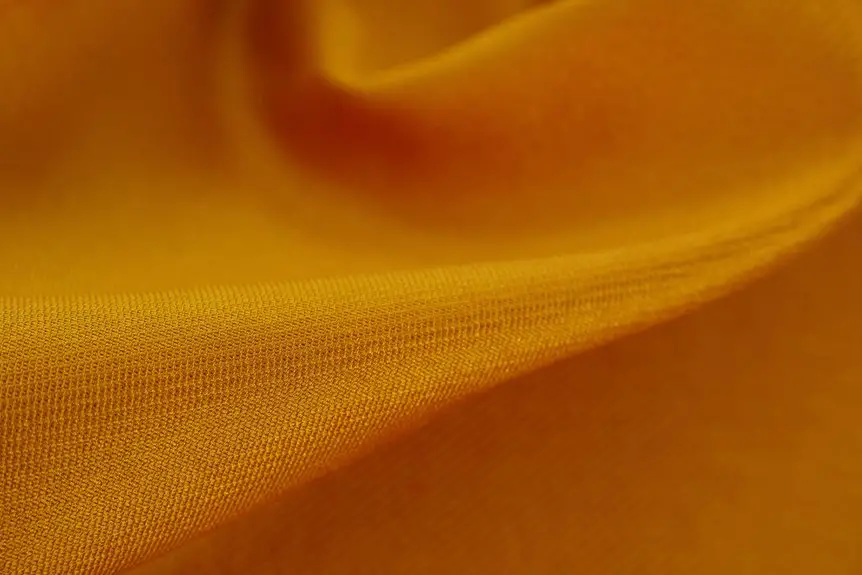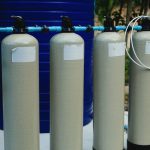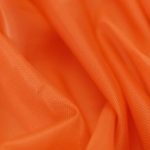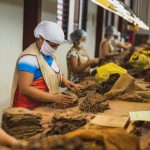You might wonder if polyester is a nonwoven fabric. Actually, polyester isn’t limited to nonwoven forms—it comes as woven, knitted, felted, and nonwoven fabrics too. Nonwoven polyester is made by bonding fibers without weaving, producing lightweight and cost-effective materials commonly used in medical and filtration products. While nonwoven polyester offers unique benefits, it also has limitations compared to woven or knitted types. If you explore this topic further, you’ll discover more about polyester’s manufacturing, uses, and innovations.
Table of Contents
Key Takeaways
- Polyester is a synthetic fiber that can be made into woven, knitted, nonwoven, or felted fabric forms.
- Nonwoven polyester fabric is produced by bonding fibers without weaving or knitting, creating lightweight, cost-effective materials.
- Unlike woven or knitted polyester, nonwoven fabrics lack an interlaced structure and are often used for disposable or industrial products.
- Nonwoven polyester is common in medical supplies, filtration, insulation, and geotextiles due to its durability and moisture resistance.
- While polyester can be nonwoven, it is not exclusively nonwoven; various manufacturing methods yield different textile types for diverse applications.
What Defines a Nonwoven Fabric?
Nonwoven fabrics are materials made by bonding fibers together without weaving or knitting. When you handle nonwoven fabrics, you’ll notice they don’t have the interlaced structure typical of woven textiles. Instead, fibers are mechanically, chemically, or thermally bonded to create a cohesive sheet.
This process makes nonwovens versatile, lightweight, and often more cost-effective. You’ll find them in disposable products like masks, wipes, and filters, where durability and breathability are key without the need for complex construction.
Unlike traditional fabrics, nonwovens don’t unravel, which can simplify manufacturing. When considering polyester, it’s important to recognize that polyester fibers can be used in nonwoven forms, but the defining factor is the fabric’s bonding method rather than the fiber type itself.
The Different Forms of Polyester Textiles
Although polyester fibers share the same chemical makeup, they can be transformed into various textile forms that serve different purposes.
You’ll find polyester in woven fabrics, where fibers are interlaced tightly, making them durable and suitable for clothing and upholstery.
Knitted polyester offers more stretch, perfect for activewear and sports gear.
Nonwoven polyester, on the other hand, bonds fibers directly without weaving or knitting, often used for disposable items like filters and medical textiles.
Additionally, you might encounter felted polyester, which is dense and firm, ideal for insulation or padding.
How Nonwoven Polyester Fabrics Are Manufactured
When you look closer at felted and nonwoven polyester fabrics, you’ll notice they don’t rely on traditional weaving or knitting techniques. Instead, these fabrics are made by bonding polyester fibers together through mechanical, chemical, or thermal processes.
First, polyester fibers are laid out randomly or in a specific orientation to form a web. Then, the web undergoes bonding methods like needle punching, where barbed needles interlock fibers mechanically, or heat bonding, where heat melts fiber surfaces to fuse them. Sometimes, adhesives help hold fibers together chemically.
This approach creates a fabric that’s strong, lightweight, and versatile without the complexity of weaving. By controlling fiber arrangement and bonding, manufacturers tailor nonwoven polyester fabrics for different properties and applications efficiently.
Common Uses of Nonwoven Polyester Materials
You’ll find nonwoven polyester materials playing a key role in the medical industry, especially in items like surgical masks and gowns.
They’re also widely used for filtration systems and insulation because of their durability and lightweight properties.
Let’s explore how these applications benefit from nonwoven polyester’s unique features.
Medical Industry Applications
Because nonwoven polyester materials offer excellent durability, breathability, and resistance to fluids, the medical industry relies on them extensively.
You’ll find these fabrics in many critical applications that keep healthcare environments safe and hygienic. For example, nonwoven polyester is used in:
- Surgical gowns and drapes, providing a protective barrier against contaminants.
- Disposable masks, ensuring breathability while filtering particles.
- Sterilization wraps, maintaining the sterility of medical instruments.
- Wound dressings, offering absorbency and comfort during healing.
When you use products made from nonwoven polyester, you benefit from materials designed to meet strict health standards while supporting patient care.
Their single-use nature also reduces cross-contamination risks, making them indispensable in medical settings.
Filtration and Insulation Uses
Nonwoven polyester’s ability to filter particles and provide thermal resistance makes it a popular choice beyond healthcare. When you need effective air filtration, nonwoven polyester traps dust, pollen, and other airborne contaminants efficiently.
It’s commonly used in HVAC systems, vacuum bags, and mask filters, ensuring cleaner air in your environment. For insulation, nonwoven polyester offers excellent thermal protection while remaining lightweight and moisture-resistant.
You’ll find it in home insulation, automotive interiors, and outdoor gear like sleeping bags and jackets. Its durability and resistance to mold make it a reliable material for maintaining warmth and energy efficiency.
Comparing Woven, Knitted, and Nonwoven Polyester
You’ll notice that woven polyester offers strength and durability through its tight interlacing of threads.
Knitted polyester, on the other hand, provides stretch and flexibility thanks to its looped structure.
Meanwhile, nonwoven polyester stands out for its lightweight, breathable, and often disposable nature.
Woven Polyester Characteristics
Woven polyester stands out for its structured durability and smooth texture, making it a popular choice in various applications. When you choose woven polyester, you benefit from its tight interlacing of threads, which boosts strength and resists stretching.
Unlike nonwoven fabrics, woven polyester offers better dimensional stability and longevity. Here’s what you can expect:
- Enhanced durability due to the crisscross pattern of threads.
- Resistance to wrinkles and shrinkage, keeping garments neat.
- Smooth surface ideal for printing and dyeing.
- Breathability balanced with water resistance, depending on weave tightness.
You’ll find woven polyester widely used in apparel, upholstery, and industrial textiles because it combines resilience with a polished finish that nonwoven versions can’t match.
Knitted Polyester Features
Although knitted polyester shares some qualities with woven fabrics, it offers distinct advantages in flexibility and stretch.
When you choose knitted polyester, you get a fabric constructed by interlocking loops, which makes it more elastic and comfortable than woven polyester. This elasticity allows the fabric to move with you, making it ideal for activewear, casual clothing, and items requiring a snug fit.
Unlike woven polyester, knitted versions resist wrinkling and drape smoothly over your body. However, knitted polyester may be less durable than woven types, as its looped structure can snag or lose shape over time.
Nonwoven Polyester Overview
Nonwoven polyester offers a unique alternative to woven and knitted fabrics by using bonded fibers instead of threads or loops. When you compare these textiles, you’ll notice distinct differences that affect their applications and performance.
Woven polyester is created by interlacing threads in a structured pattern, providing strength and durability. Knitted polyester uses interlocking loops, giving you stretch and comfort. Nonwoven polyester, however, bonds fibers together through heat, chemicals, or pressure, resulting in a fabric that’s lightweight and breathable but less flexible.
Here’s a quick comparison to keep in mind:
- Woven: strong, durable, less stretch
- Knitted: stretchy, comfortable, flexible
- Nonwoven: lightweight, breathable, cost-effective
- Nonwoven: often disposable or specialized uses
Understanding these differences helps you choose the right polyester fabric for your needs.
Advantages and Disadvantages of Nonwoven Polyester
Since you’re exploring polyester textiles, it’s important to know that nonwoven polyester offers unique benefits and some drawbacks. You’ll appreciate its durability and resistance to moisture, making it ideal for applications like medical masks, filters, and geotextiles.
Nonwoven polyester is durable and moisture-resistant, perfect for medical masks, filters, and geotextile applications.
It’s lightweight and cost-effective, so you won’t have to worry about high production expenses. Plus, its quick manufacturing process means you get products faster.
On the downside, nonwoven polyester isn’t as breathable or flexible as woven fabrics, which can limit comfort in clothing applications. It also tends to shed microfibers, raising environmental concerns.
Additionally, its strength may decrease under prolonged UV exposure, so it’s not always ideal for outdoor use. Knowing these pros and cons helps you decide when nonwoven polyester fits your project best.
Innovations and Future Trends in Polyester Fabric Technology
As polyester continues to dominate the textile industry, innovations are pushing its capabilities beyond traditional uses.
You’ll see advancements focusing on sustainability, performance, and versatility. For example, recycled polyester reduces waste, while smart fabrics integrate sensors for health monitoring.
Additionally, eco-friendly dyeing methods minimize environmental impact, and biodegradable polyester variants are emerging to tackle pollution issues.
Here are four key future trends you should watch:
- Increased use of recycled and bio-based polyester fibers.
- Development of polyester blends with enhanced moisture-wicking and UV protection.
- Integration of nanotechnology for stain resistance and self-cleaning properties.
- Expansion of smart textiles incorporating polyester for wearable tech.
Frequently Asked Questions
Can Polyester Nonwoven Fabrics Be Recycled?
Did you know about 25% of polyester nonwoven fabrics can be recycled? You can recycle them, but it depends on local facilities. Check your area’s recycling options to guarantee these fabrics don’t end up in landfills.
How Does Polyester Nonwoven Fabric Affect Skin Sensitivity?
You might find polyester nonwoven fabric irritating if you have sensitive skin since it can trap heat and moisture. However, many people tolerate it well, especially if the fabric is treated for breathability and softness.
Are Polyester Nonwoven Fabrics Biodegradable?
Polyester nonwoven fabrics aren’t biodegradable since they’re made from synthetic polymers. You’ll find they persist in the environment for a long time, so consider eco-friendly alternatives if biodegradability matters to you.
What Are the Environmental Impacts of Producing Polyester Nonwoven Fabrics?
You’ll love how producing polyester nonwoven fabrics guzzles energy and emits greenhouse gases—nature’s favorite party crashers. Plus, they rely on petroleum, so you’re basically celebrating plastic while harming the planet. Not your eco-friendly win.
How Does Polyester Nonwoven Fabric Compare in Cost to Natural Fibers?
You’ll find polyester nonwoven fabric typically costs less than natural fibers because it’s cheaper to produce and process. Its synthetic nature lets manufacturers scale up quickly, saving you money compared to pricier, labor-intensive natural options.
- Does Chiffon Fabric Stink - July 15, 2025
- Does Chiffon Fabric Affect the Economy - July 15, 2025
- Does Cotton Fabric Have a Nap - July 15, 2025






